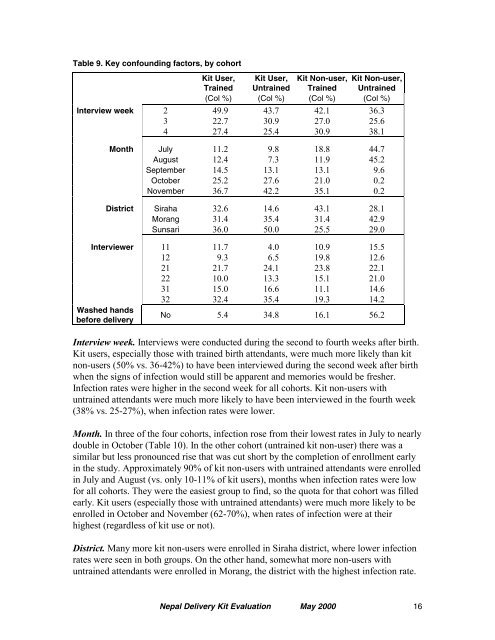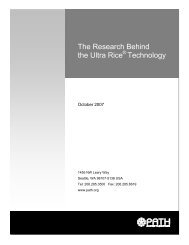Nepal Clean Home Delivery Kit: Evaluation of the Health Impact - Path
Nepal Clean Home Delivery Kit: Evaluation of the Health Impact - Path
Nepal Clean Home Delivery Kit: Evaluation of the Health Impact - Path
You also want an ePaper? Increase the reach of your titles
YUMPU automatically turns print PDFs into web optimized ePapers that Google loves.
Table 9. Key confounding factors, by cohort<br />
<strong>Kit</strong> User, <strong>Kit</strong> User, <strong>Kit</strong> Non-user, <strong>Kit</strong> Non-user,<br />
Trained Untrained Trained Untrained<br />
(Col %) (Col %) (Col %) (Col %)<br />
Interview week 2 49.9 43.7 42.1 36.3<br />
3 22.7 30.9 27.0 25.6<br />
4 27.4 25.4 30.9 38.1<br />
Month July 11.2 9.8 18.8 44.7<br />
August 12.4 7.3 11.9 45.2<br />
September 14.5 13.1 13.1 9.6<br />
October 25.2 27.6 21.0 0.2<br />
November 36.7 42.2 35.1 0.2<br />
District Siraha 32.6 14.6 43.1 28.1<br />
Morang 31.4 35.4 31.4 42.9<br />
Sunsari 36.0 50.0 25.5 29.0<br />
Interviewer 11 11.7 4.0 10.9 15.5<br />
12 9.3 6.5 19.8 12.6<br />
21 21.7 24.1 23.8 22.1<br />
22 10.0 13.3 15.1 21.0<br />
31 15.0 16.6 11.1 14.6<br />
32 32.4 35.4 19.3 14.2<br />
Washed hands<br />
before delivery<br />
No 5.4 34.8 16.1 56.2<br />
Interview week. Interviews were conducted during <strong>the</strong> second to fourth weeks after birth.<br />
<strong>Kit</strong> users, especially those with trained birth attendants, were much more likely than kit<br />
non-users (50% vs. 36-42%) to have been interviewed during <strong>the</strong> second week after birth<br />
when <strong>the</strong> signs <strong>of</strong> infection would still be apparent and memories would be fresher.<br />
Infection rates were higher in <strong>the</strong> second week for all cohorts. <strong>Kit</strong> non-users with<br />
untrained attendants were much more likely to have been interviewed in <strong>the</strong> fourth week<br />
(38% vs. 25-27%), when infection rates were lower.<br />
Month. In three <strong>of</strong> <strong>the</strong> four cohorts, infection rose from <strong>the</strong>ir lowest rates in July to nearly<br />
double in October (Table 10). In <strong>the</strong> o<strong>the</strong>r cohort (untrained kit non-user) <strong>the</strong>re was a<br />
similar but less pronounced rise that was cut short by <strong>the</strong> completion <strong>of</strong> enrollment early<br />
in <strong>the</strong> study. Approximately 90% <strong>of</strong> kit non-users with untrained attendants were enrolled<br />
in July and August (vs. only 10-11% <strong>of</strong> kit users), months when infection rates were low<br />
for all cohorts. They were <strong>the</strong> easiest group to find, so <strong>the</strong> quota for that cohort was filled<br />
early. <strong>Kit</strong> users (especially those with untrained attendants) were much more likely to be<br />
enrolled in October and November (62-70%), when rates <strong>of</strong> infection were at <strong>the</strong>ir<br />
highest (regardless <strong>of</strong> kit use or not).<br />
District. Many more kit non-users were enrolled in Siraha district, where lower infection<br />
rates were seen in both groups. On <strong>the</strong> o<strong>the</strong>r hand, somewhat more non-users with<br />
untrained attendants were enrolled in Morang, <strong>the</strong> district with <strong>the</strong> highest infection rate.<br />
<strong>Nepal</strong> <strong>Delivery</strong> <strong>Kit</strong> <strong>Evaluation</strong> May 2000 16
















